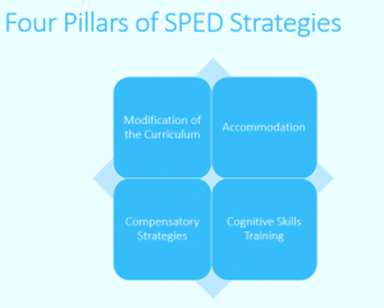The percentage of students classified as “special ed” across the country is currently about 13 percent. We have come across schools where the proportion of students receiving specialized services is as high as 30 percent or more. And in some of our testing, we see 70 percent or more of students living in poverty showing cognitive deficits. Does it make sense to classify 70 percent of a school as special ed? Not usually, although of course, there are some schools dedicated to serving students with special needs, and that is a different story.
It is our belief that many schools have far too many students in special ed. If we helped students develop their underlying cognitive skills, no matter why they are low (poverty is just one reason), then we and they could avoid the labels and the expensive processes and the conflict that classification often entails. At the same time, we would have the ability to better serve the students who really do need those supports.
Specific Learning Disabilities
About 40 percent of the special education population in schools across the country are diagnosed with specific learning disabilities. A specific learning disability is a disorder in one or more of the basic psychological or cognitive processes involved in learning and that affects a student’s ability to read, write or do math. Students accorded special education services under other IDEA (individuals with Disabilities Education Act) categories also have deficits in underlying cognitive processes. These can include students with autism, speech or language impairment, and traumatic brain injury. Thus, it seems likely that a majority of students classified to receive special education (SPED) services have underlying cognitive reasons for their struggles with academic work.
When a student is formally recognized as having a disability that involves underlying cognitive processes, educators and educational systems have developed a portfolio of strategies and approaches to help support that student academically. Generally, these approaches or strategies fall into one of three categories:
Accommodations Examples
- Additional time to complete work
- Note-taking assistance
- Verbal vs. written instructions
Modifications of the Curriculum Examples
- Additional instruction
- Short, simple instructions
- More explicit connections to prior knowledge
- Texts written at a lower grade level
- Less work (e.g., fewer spelling words)
Compensatory Strategies Examples
- Categorization
- Graphic organizers
- Mnemonics
- Multi-sensory instruction and practice
What is important to understand about these strategies is that their purpose is to bypass the cognitive processes that are weak in order to minimize the impact of processing deficits.
So, if a student has poor working memory and can’t remember a set of instructions, the teacher will eliminate the need for the student to remember a list of things. Instead of saying, “Teddy, take out your pencil, open the text booklet and write you name at the top,” we would say start with, “Teddy, take out your pencil,” and wait for him to do that before proceeding with the next step.
But, what if Teddy could develop his working memory? What if other students could improve the efficiency and accuracy of their visual perception, their processing speed, their attention, their ability to retain the sequence and where they are in a multiple-step problem solution? What if the brain and cognitive processes were malleable? If all those things were possible, then we would have another approach or strategy to add to our toolkit – remediation of underlying cognitive weaknesses.
We now know that the brain and cognitive processes are far more amenable to change than was originally thought. We are referring, of course, to neuroplasticity. Neuroplasticity means that our brains change and when we understand what is involved in those changes, we can remediate weaknesses in underlying cognitive processes.
Consider a group of elementary school students diagnosed with Specific Learning Disabilities who used a cognitive training software in their school. Students in the study who used the program for 12 weeks improved their cognitive functioning by 2.8 years, compared to 2 months for the control group. This improvement raised the student’s overall cognitive proficiency level from 64 percent to 89 percent where 90 percent is the expected performance for a normally developing student. Students in the control group improved just one percentage point, from 63 percent to 64 percent proficiency. Students in the treatment group also improved their reading and math scores by 0.8 and 1.0 grade equivalent respectively over the 12 weeks.
According to Dr. Sarah Avtzon, who conducted the study described above as part of her doctoral dissertation, the implication is clear. Remediation of cognitive processes needs to be a fourth pillar in our approach to support students in special education.

Click here to read more about Dr. Avtzon’s work and other studies of the impact of cognitive training for students in special education.
About the authors

Betsy Hill is President of BrainWare Learning Company, a company that builds learning capacity through the practical application of neuroscience. She is an experienced educator and has studied the connection between neuroscience and education with Dr. Patricia Wolfe (author of Brain Matters) and other experts. She is a former chair of the board of trustees at Chicago State University and teaches strategic thinking in the MBA program at Lake Forest Graduate School of Management where she received a Contribution to Learning Excellence Award. She received a Nepris Trailblazer Award for sharing her knowledge, skills and passion for the neuroscience of learning in classrooms around the country. She holds a Master of Arts in Teaching and an MBA from Northwestern University.

Roger Stark is Co-founder and CEO of the BrainWare Learning Company. Over the past decade, he championed efforts to bring comprehensive cognitive literacy skills training and cognitive assessment within reach of every person, and it all started with one very basic question: What do we know about the brain? From that initial question, Roger Stark pioneered the effort to build an effective and affordable cognitive literacy skills training tool, based on over 50 years of trial and error through clinical collaboration. He also led the team that developed BrainWare SAFARI, which has become the most researched comprehensive, integrated cognitive literacy training tool delivered online anywhere in the world. For more, follow BrainWare Learning on Twitter @BrainWareSafari










